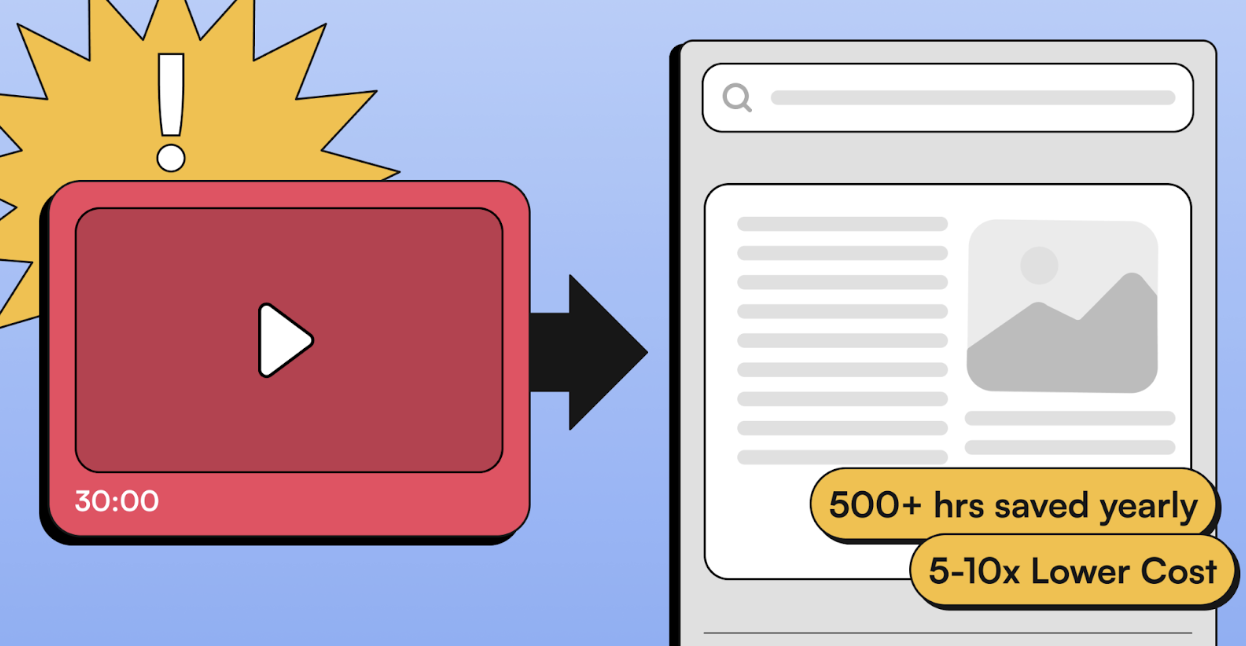The Healthcare Team That Tamed Its Frankenstein App With AI
Published on
October 23, 2025























Ever tried to document a product so customized it barely resembles the original? One healthcare tech team had...and their support queue proved it. Then Brainfish showed up, turned short vendor videos into living help docs, and gave compliance something to celebrate instead of question. No rewrites. No guesswork. Just documentation that finally kept up.
Note: Some company names and personal details have been anonymized to protect confidentiality while preserving the insights from this conversation.
When the engineering lead of a major healthcare tech company joined our demo call, he didn’t waste time with pleasantries.
“How much are you aware of the customization we’ve done?” he asked, jokingly (kind of). “The whole UI has been redesigned for us. It’s true customization.”
Translation: We’ve Frankensteined this thing, and no documentation on Earth can keep up.
Their support team was drowning in tickets about features that only existed in their version of the product. No one knew where anything lived. The user guide was as relevant as a 2013 iPhone manual, if there ever was one.
“When Brainfish responds,” he pressed, “does it factor in that customization? Or does it just parrot back generic product info?”
The answer from Brainfish CEO Daniel Kimber caught the room off guard (gasp!) because it didn’t involve writing more documentation at all.
The Customization Problem (And Why Healthcare Makes It Worse)
For heavily regulated healthcare organizations, documentation is a recurring migraine. Every implementation is different. Every compliance rule requires proof. Every update adds another inch to the pile.
Standard product documentation doesn’t apply. Creating custom docs takes forever. And by the time you finish, it’s already outdated.
So when the company’s infrastructure lead asked, “Is this part of our current licensing, or would this be an add-on?” Daniel’s answer shifted the conversation. It would be included, at no extra cost, during the pilot.
Then came the bigger surprise: the healthcare team wouldn’t have to create a single document themselves. Their software vendor would record short product walkthrough videos (and Brainfish would automatically turn those into a complete, customized knowledge base).
Two and a Half Minutes to a Knowledge Base
In the demo, a 2.5-minute feature video transformed into five complete help articles, each with text, screenshots, and video snippets pulled from the original recording.
“What we’d do,” Daniel explained, “is have your team record a quick overview of the feature. We’ll upload it, and Brainfish will generate documentation showing exactly what’s there.”
The project manager leaned forward (actually). Their team had spent months trying to document similar updates. Watching that same work happen in minutes was like seeing time itself bend.
Even ongoing updates were handled elegantly. If the new video only changed ten percent of existing content, Brainfish would flag just those portions for review. “We’ll tell you what changed,” Daniel said, “and you can approve it.”
That line - you can approve it - hit differently in a room where governance was priority #1.
Compliance, Governance, and “AI” in Healthcare
Healthcare organizations don’t get to experiment freely. Every new tool goes through layers of compliance checks, security reviews, and SOC 2 validations before anyone can click “Enable.”
“We’re under a high-compliance healthcare model,” the engineering lead said. “Anything AI, we have to document and justify as part of our governance.”
It was a fair concern - and a familiar one. Brainfish’s own SOC 2 Type 2 compliance meant this wasn’t a roadblock, just a box to check. The team would still run their due diligence, but the groundwork was already there.
This wasn’t “move fast and break things.” It was move fast and still get legal to sign off.
The Pilot: Small Scope, Big Impact
Instead of diving into a massive rollout, both sides agreed on a two-week pilot - short enough to stay lightweight, long enough to prove value.
Implementation? One line of code.
Control? Toggle it on or off anytime.
Visibility? Full analytics on usage and effectiveness.
The engineering lead immediately asked about scope. “Would this be across all centers, or can we pick and choose?”
They could start small. Limit it to specific locations. Expand later. For a compliance-driven team, that flexibility wasn’t just nice to have - it was essential.
When AI Meets the Human Handoff
One question kept coming up: What happens when AI doesn’t know the answer?
Daniel showed how unanswered queries could create tickets automatically or route directly to a support rep.
“You’ll still get the answer first,” he explained, “but we’ll make it easy to talk to a human if needed.”
It wasn’t about replacing support staff - it was about letting humans focus on the high-value problems while AI handled the repeat offenders.
As the conversation wrapped, the vendor’s support lead summed it up: “If this helps deflect tickets, find better answers, and improve efficiencies, we can bring this to our executive leadership and expand it system-wide.”
Beyond Cost Savings: A Different Kind of ROI
Yes, the pilot was free. The real win was in reclaiming time, accuracy, and trust.
The healthcare company’s support team could now answer complex, custom questions instantly. Their vendor could identify common issues across deployments. And new hires could onboard without hour-long shadowing sessions.
For the first time, documentation wasn’t a blocker. It was a competitive advantage.
The Path Forward
The next steps were clear:
- Complete security questionnaires
- Share the demo internally
- Define pilot scope
- Launch before end of September
“I appreciate that you think we’re cool enough for this pilot,” the engineering lead said, laughing.
They weren’t picked for being cool. They were picked because their setup was hard.
If Brainfish could handle their documentation chaos - the custom UIs, the compliance gates, the healthcare edge cases - it could handle anyone’s. Dramatic, we know.
What This Means for Healthcare IT
This pilot was a glimpse at a new model for enterprise knowledge management - one where customization isn’t a liability but a living data source.
When documentation can be generated directly from the work teams are already doing, knowledge stays current by default. No more outdated guides. No more lost context. No more “we’ll update that later.”
For healthcare, where accuracy and auditability are everything, this shift is enormous.
Want to see it for yourself? Book a demo and watch your knowledge base keep up with your product for once. Sorry, not intentionally throwing shade. We just know not every knowledge base is 100% accurate all the time.
import time
import requests
from opentelemetry import trace, metrics
from opentelemetry.sdk.trace import TracerProvider
from opentelemetry.sdk.metrics import MeterProvider
from opentelemetry.sdk.trace.export import ConsoleSpanExporter, SimpleSpanProcessor
from opentelemetry.sdk.metrics.export import ConsoleMetricExporter, PeriodicExportingMetricReader
# --- 1. OpenTelemetry Setup for Observability ---
# Configure exporters to print telemetry data to the console.
# In a production system, these would export to a backend like Prometheus or Jaeger.
trace.set_tracer_provider(TracerProvider())
tracer = trace.get_tracer(__name__)
span_processor = SimpleSpanProcessor(ConsoleSpanExporter())
trace.get_tracer_provider().add_span_processor(span_processor)
metric_reader = PeriodicExportingMetricReader(ConsoleMetricExporter())
metrics.set_meter_provider(MeterProvider(metric_readers=[metric_reader]))
meter = metrics.get_meter(__name__)
# Create custom OpenTelemetry metrics
agent_latency_histogram = meter.create_histogram("agent.latency", unit="ms", description="Agent response time")
agent_invocations_counter = meter.create_counter("agent.invocations", description="Number of times the agent is invoked")
hallucination_rate_gauge = meter.create_gauge("agent.hallucination_rate", unit="percentage", description="Rate of hallucinated responses")
pii_exposure_counter = meter.create_counter("agent.pii_exposure.count", description="Count of responses with PII exposure")
# --- 2. Define the Agent using NeMo Agent Toolkit concepts ---
# The NeMo Agent Toolkit orchestrates agents, tools, and workflows, often via configuration.
# This class simulates an agent that would be managed by the toolkit.
class MultimodalSupportAgent:
def __init__(self, model_endpoint):
self.model_endpoint = model_endpoint
# The toolkit would route incoming requests to this method.
def process_query(self, query, context_data):
# Start an OpenTelemetry span to trace this specific execution.
with tracer.start_as_current_span("agent.process_query") as span:
start_time = time.time()
span.set_attribute("query.text", query)
span.set_attribute("context.data_types", [type(d).__name__ for d in context_data])
# In a real scenario, this would involve complex logic and tool calls.
print(f"\nAgent processing query: '{query}'...")
time.sleep(0.5) # Simulate work (e.g., tool calls, model inference)
agent_response = f"Generated answer for '{query}' based on provided context."
latency = (time.time() - start_time) * 1000
# Record metrics
agent_latency_histogram.record(latency)
agent_invocations_counter.add(1)
span.set_attribute("agent.response", agent_response)
span.set_attribute("agent.latency_ms", latency)
return {"response": agent_response, "latency_ms": latency}
# --- 3. Define the Evaluation Logic using NeMo Evaluator ---
# This function simulates calling the NeMo Evaluator microservice API.
def run_nemo_evaluation(agent_response, ground_truth_data):
with tracer.start_as_current_span("evaluator.run") as span:
print("Submitting response to NeMo Evaluator...")
# In a real system, you would make an HTTP request to the NeMo Evaluator service.
# eval_endpoint = "http://nemo-evaluator-service/v1/evaluate"
# payload = {"response": agent_response, "ground_truth": ground_truth_data}
# response = requests.post(eval_endpoint, json=payload)
# evaluation_results = response.json()
# Mocking the evaluator's response for this example.
time.sleep(0.2) # Simulate network and evaluation latency
mock_results = {
"answer_accuracy": 0.95,
"hallucination_rate": 0.05,
"pii_exposure": False,
"toxicity_score": 0.01,
"latency": 25.5
}
span.set_attribute("eval.results", str(mock_results))
print(f"Evaluation complete: {mock_results}")
return mock_results
# --- 4. The Main Agent Evaluation Loop ---
def agent_evaluation_loop(agent, query, context, ground_truth):
with tracer.start_as_current_span("agent_evaluation_loop") as parent_span:
# Step 1: Agent processes the query
output = agent.process_query(query, context)
# Step 2: Response is evaluated by NeMo Evaluator
eval_metrics = run_nemo_evaluation(output["response"], ground_truth)
# Step 3: Log evaluation results using OpenTelemetry metrics
hallucination_rate_gauge.set(eval_metrics.get("hallucination_rate", 0.0))
if eval_metrics.get("pii_exposure", False):
pii_exposure_counter.add(1)
# Add evaluation metrics as events to the parent span for rich, contextual traces.
parent_span.add_event("EvaluationComplete", attributes=eval_metrics)
# Step 4: (Optional) Trigger retraining or alerts based on metrics
if eval_metrics["answer_accuracy"] < 0.8:
print("[ALERT] Accuracy has dropped below threshold! Triggering retraining workflow.")
parent_span.set_status(trace.Status(trace.StatusCode.ERROR, "Low Accuracy Detected"))
# --- Run the Example ---
if __name__ == "__main__":
support_agent = MultimodalSupportAgent(model_endpoint="http://model-server/invoke")
# Simulate an incoming user request with multimodal context
user_query = "What is the status of my recent order?"
context_documents = ["order_invoice.pdf", "customer_history.csv"]
ground_truth = {"expected_answer": "Your order #1234 has shipped."}
# Execute the loop
agent_evaluation_loop(support_agent, user_query, context_documents, ground_truth)
# In a real application, the metric reader would run in the background.
# We call it explicitly here to see the output.
metric_reader.collect()Recent Posts...
You'll receive the latest insights from the Brainfish blog every other week if you join the Brainfish blog.











